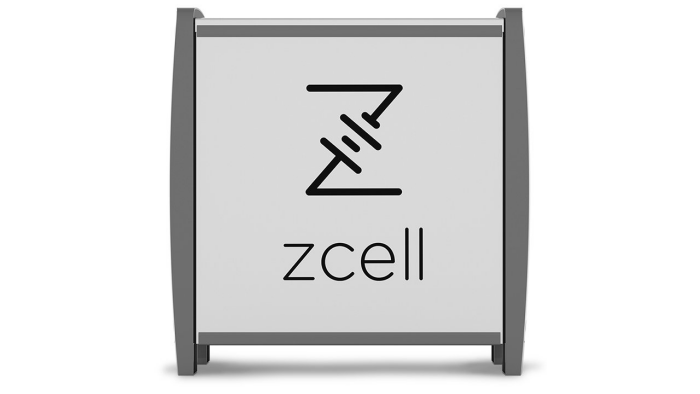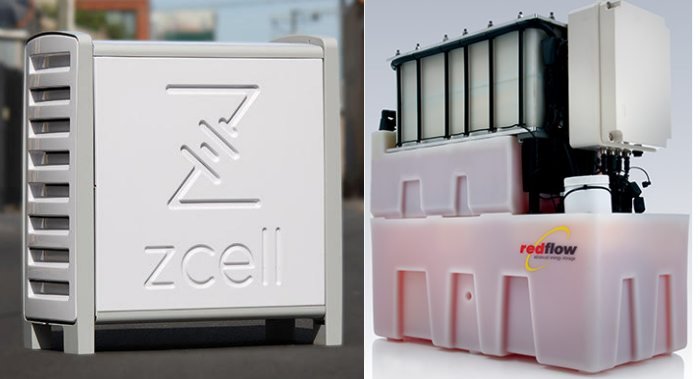Flow Batteries and Solar Battery Storage

A Redflow Zcell zinc-bromide battery
One of the more recent developments in the solar battery storage space are ‘flow’ batteries; or ‘zinc-bromine flow batteries’ if you want to get technical!
Flow batteries actually describe a number of similar technologies that all fall under the same umbrella, but this page will predominantly discuss the ‘ZCell‘ Zinc-Bromide batteries that were manufactured by the Australian company RedFlow.
Note: as at July 2022, it doesn’t appear the ZCell is still being manufactured.
How Do Flow Batteries Work?
Discussing the science behind flow batteries can get rather technical, so I’ll massively simplify it and relate the explanation to the ZCell.
A ZCell flow battery is mostly made up of a water-based zinc bromide solution that flows between two tanks. When the battery charges, the zinc is extracted from the liquid and stored separately on plates. When discharging, the zinc is put back into the liquid. These processes are called “plating” and “deplating”.
The zinc bromide solution ‘flows’ from the big plastic tank stored in the bottom of the unit to the electrodes at the top (called the “stack”). The following image (right) depicts the ZBM2, which formed the basis of the ZCell (left), showing the flow battery’s tanks and stack.
Note: on July 7, 2022, Redflow announced the “Gen3” ZBM3 had gone into commercial production, but there was no mention of ZCell.
One of the major advantages flow batteries have over lithium-ion and lead-acid batteries is that they offer a 100% depth-of-discharge – which means the battery can be entirely discharged in a cycle with no negative effects on the lifespan of the battery.
For comparison, lead-acid batteries have a 60% depth-of-discharge, and lithium-ion batteries have around an 80% depth-of-discharge.
There are a number of other benefits that flow batteries offer:
- They can tolerate extreme weather conditions, up to 50 degrees Celsius.
- The zinc-bromine liquid inside the flow batteries is a natural fire retardant.
- There is no chance of a thermal runaway (explosion!) due to the physical separation of the different battery components.
- Flow batteries are cheaper to refurbish due to their simple modular construction. For example, you can restore a ‘dead’ battery by simply swapping the electrode – for half of the original price of the battery.
A disadvantage of the ZCell was its expected life cycle compared to lithium-ion batteries – it had a lifespan of approximately 4000 cycles at 100% depth-of-discharge, which is less than lithium-ion’s 5000-6000 cycles at 80% depth-of-discharge.
How much do flow batteries cost?
The Redflow Zcell (a 10kWh battery) cost around $12,600 AUD, not including inverter or installation. You’d also need a solar system size of at least 5kW to be able to charge your batteries consistently, which cost roughly $5,000 – $6,000. So, a ready-to-go setup would have cost north of $17,600 – $18,600 AUD at the time it was available.
It was a lot of money for the average Australian household to find, even if they were extremely keen on adding solar battery storage to their PV system.
Cost is also still a barrier with widely available lithium-ion home batteries. My recommendation in many situations is to wait for home battery prices to drop before adding one to a home solar power system. But if the economics of a battery aren’t the number one priority for you (people have various reasons for wanting one), you’ve crunched the numbers and you’re OK with those numbers, then go for it!
Discover everything you need to know about buying home batteries here.
The future of the home flow battery
Flow batteries could *potentially* compete with lithium-ion batteries in the home segment. But first, flow battery manufacturers need to get (and keep) quality products on the market, and costs down to a level reasonable for mass-market adoption.
One other flow battery still in the works for the Australian home grid-connect market is a (comparatively gigantic) vanadium flow battery from VSUN; but we haven’t heard anything about it for quite some time.
